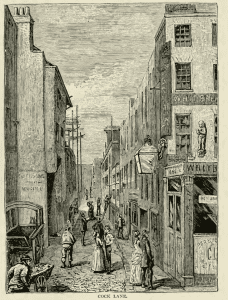Have you heard of The Ghost of Cock Lane? Join London Tour Guide, Hazel Baker as she share this rather unusual Georgian ghost story in London History Podcast’s Halloween Special Episode.
London Guided Walks » Episode 28: The Ghost of Cock Lane Special
Episode 28: The Ghost of Cock Lane Special
Book a Private Tour with Hazel:
Show Notes:
 Hazel Baker: Hello and welcome to London Guided Walks London History podcast. In the coming episodes, we will be sharing our love and passion for London, its people, places and history in an espresso shot with a splash of personality. For those of you who don’t know me, I am Hazel Baker, founder of London Guided Walks, providing guided walks and private tours to Londoners and visitors alike.
Hazel Baker: Hello and welcome to London Guided Walks London History podcast. In the coming episodes, we will be sharing our love and passion for London, its people, places and history in an espresso shot with a splash of personality. For those of you who don’t know me, I am Hazel Baker, founder of London Guided Walks, providing guided walks and private tours to Londoners and visitors alike.
I like to celebrate the change of the season when the autumn air blows with a slight chill and the leaves turn a wonderful shade of burnt orange. I like to snuggle up with a mug of my homemade vanilla chai and a book or two. And this time it was Charles Dickens’ A Tale Of Two Cities. And as I read through the preface, well, doesn’t everybody? I was reminded of The Ghost of Cock Lane. And does Halloween approaches, I thought I would share this with you. It’s a rather unusual Georgian ghost story.

In 1806, The Ghost of Cock Lane was dead. 40 years prior to this event, the haunting of Cock Lane gripped the nation’s imagination and sent a combined ripple of fear and excitement through the rich and poor of London alike. In 1762 London’s population have now reached three quarters of a million people with 54% of them being women. Many of them young having come from the country in search of work, often in domestic service. London was a place where you could become someone else, like Fanny. Fanny was from a good family in Norfolk. She had left her brothers and the rest of her family and all her loved ones and come to London to live with William Kent. William too was from Norfolk and have come to London for a new life and they wanted to start that life together.
The couple went to morning prayers at St. Sepulchre Church, which is just on the other side of the Old Bailey and still stands today. It was there where they spoke to the officiating clerk of St. Sepulchre and gentlemen, by the name of Richard Parsons, and they asked if he knew of any suitable lodgings in the neighbourhood.
Paulson’s offered a couple of rooms in his own house in Cock Lane, which was round the corner from the church. And the Kents accepted and moved in. Unbeknown to the Kents, Paulson was a known drunk. Unbeknown to the Parsons, the Kents weren’t married. Fanny’s sister was married to Kent and had died a year before.
By whatever means, Parsons ended up borrowing 12 guineas from the Kents with the agreement that Parsons would pay it back a Guinea per month. While Kent was away, Fanny, decided to share rooms with the Parsons’ 11 year old daughter by the name of Elizabeth. The next morning, Fannie complained to the household of having been disturbed in the night by loud noises.
Mrs. Paulson suggested it was the neighbouring shoemaker working late into the night. But the next night the noises returned. But this time Fanny woke the household and invited them to hear the noises for themselves. A neighbour of the Parsons and landlord by the name of James Frazen bull witnessed to the first appearance of The Ghost of Cock Lane.
Frazen said he saw a white ghostly figure climb the stairs of the house. And the interest of the ghost increased. The Kents moved out of the Parsons without having their loan repaid. And a Miss Katherine Friend moved in instead.
The Kents moved a couple of doors down on Cock Lane, not too far at all. And it was there that Fannie fell ill. She was first diagnosed with an eruptive fever, which seemed developed into smallpox. She died shortly after. Smallpox was probably the single most lethal disease in 18th century Britain. Most adult smallpox victims would , like Fanny, who hadn’t encountered smallpox in childhood. In London, smallpox accounted for six to 10% of all burials in 1760 and mortality rates to have seemed to have really peaked at that time as well before declining slowly.
Arranging a funeral for Fanny was not without its challenges for poor William Kent, as they hadn’t been married. Kent’s name was recorded on Fanny’s death certificate and Kent inherited 150 pounds. Plus some land Fanny had inherited from her brother. Her family weren’t happy and they did challenge the will, but this attempt failed.
With his new found wealth, Kent retrained as a stockbroker and remarried within a couple of years. He still hadn’t received payment from Parsons though. And so took legal action, which was successful. Seeing Kent move up in the world might have been rather hard on old Parsons who was drinking away his own fortune. And this may have been the trigger for The Ghost of Cock Lane to now return.
Ms Friend moved out as she couldn’t deal with the noise of this ghost and now Parsons, have less money coming in ever. And so when the ghost visited, Parsons asked questions and the ghost responded by using a series of knocks, it was there where he ascertained the ghost to beat poor bunny Kent.
Parson’s questioning revealed that the ghosts accused her husband, Mr. Kent of poisoning her by putting arsenic into Pearl and administering it during her illness with smallpox. And only when Kent is hanged, could she then rest in peace?
Paulson’s daughter, Elizabeth, claimed she have seen the ghost. Without hands in a shroud. Others claims who have seen the ghost too having described it with hands or luminous and shining. The story of the ghost of cock lane spread throughout London and was extensively publicized in the public ledger. And it said that thousands of people from all levels of society came to experience the ghost.
Even Horace Walpole attended one of the many seances there and wrote to his friend Montague of his visit.
“I went to hear it for it is not an apparition, but an audition. We set out from the opera, changed our clothes at Northumberland House. The Duke of York, Lady Northumberland, Lady Mary Cook, Lady Hartford, and I all in a Hackney coach drove to the spot.
It rained in Torrance yet the lane was full of mob and the house is full. We could not get in. At last, they discovered it was the Duke of York and the company squeeze themselves into one another’s pockets to make room for us. The house, which is borrowed and to which the ghost had adjourned is wretchedly small and miserable.
When we opened the chamber in which where 50 people with no lights but one tallow candle at the end, we tumbled over the bed of the child to whom the ghost comes. At the top of the room, our ropes to dry clothes.
I asked if we were to have a rope dancing between the acts. We heard nothing. We stayed till half an hour after one. Provisions are sent in like forage and all the taverns and ale houses in the neighbourhood make fortunes.”
So many businesses in Cock Lane were flourishing, whereas Kent’s reputation was in tatters and also he’d been tarred as a wife murderer. Parsons too was doing a roaring trade by allowing anyone to enter his home in the hope of experiencing Fanny’s knocking ghost. And obviously all for a small fee.
The ghost told a gathered crowd that it would follow Parson’s daughter, Elizabeth, everywhere. And so Elizabeth moved into the house of Reverend Mr. Old Rich. Her father was allowed to be in the house as well, but not in the same room. The girl’s bed was put in the middle of a large room and chairs were placed around it.
An advert by Reverend Mr. Old Rich and also James Penn, lecturer of St. Anne’s oldest gate, try to explain to the public what they were trying to achieve.
“We have done and still are ready to do everything in our power to detect an imposture, if any of the most unhappy tendency, both to the public and individuals.”
At 10:00 PM on 31st of January 1763, these gentlemen of established character watched an 11 year old get ready for bed with the help of several ladies. And they sat and waited for more than an hour before going downstairs and interrogating Paulsons. He denied any knowledge or belief of fraud.
They were called back into the room however, when ladies having heard the knocks and scratches and Elizabeth had felt the spirit like a mouse upon her back. Prior to this, the spirit had publicly promised by an affirmative knock that it would attend one of the gentlemen into the volt under the church of St. John Clerkenwell, where Fanny’s body had been left. And that the ghost would knock upon a coffin.
And so the men decided to follow up on that. And so this group of learned men at 1:00 AM, went to the church. The men found 315 coffins laid out on the floor of the public volts out of those 315 coffins, 154 without nameplates. Fanny’s coffin was one of those. She had left Kent 150 pounds and land and yet he couldn’t be bothered to pay for a nameplate for her coffin? Is that love? Fanny’s coffin was discovered in the North side of the crypt, bricked up with the rest of the coffins. WP Griffiths described her remains having been turned quite black.
The men waited at the coffin, but the ghost failed to fulfil her promise. Attending was John Moore who announced:
“I do hereby certify that those from the several attendances on this occasion, I have not been able to point out how and in what manner, those knockings and scratchings of the supposed ghost work and tried, performed and continued. Yet that I am convinced that those knockings and scratchings were the effects of some artful wicked contrivance.
Dr. Samuel Johnson was one of the attendees in such a wrists. Charles Churchill ridiculed them in his work, the ghost.
“Through the dull deep surrounding, glooming, close array towards Fanny’s tomb, adventure forth. Caution before with healthful step a lengthen bore. Pointing at graves and in the rear trembling and talking loud, went fear. At length, they reached the place of death. Her fault it was long time applied to hold the last remains of pride. Thrice each the ponderous key applied and thrice to turn it vainly tried till taught by prudence to unite and straining with collected might. The stubborn wards resist no more, but open flies, the growling door. Three paces back, they fell amazed like statues stood like mad men gazed. How would the wicked ones rejoice and infidels exalt their voice, if Parsons and plausible were found by shadows awed to quit their ground. How could falls laugh? Should it appear? Palm Pozo was the slave of fear. Silent all three went in about all three turns silent and came out.”
It was then decided that Elizabeth should be moved from house to house. House on the strand and then waning Covent Garden. And she was reportedly, constantly attended by the unusual noises. It was even said that the sounds could be heard in rooms as a considerable distance from her. And for two consecutive nights, her bed was made into a hammock about one and a half yards from the ground. And a hands and feet were extended and fastened. Even with being threatened of her and a family being sent to new gate prison, Elizabeth said, and did nothing.
The investigation took a turn when the girl was seen concealing a small board underneath her stays. And the servants informed the investigators. And the whole thing was proven to be a hoax. Kent indicted Parsons, his wife and daughter, and several others.
And on the 10th of July, 1762, they were tried at Guild Ball by a special jury, and they were convicted of conspiracy. The sentence was deferred for several months to give the offenders an opportunity to making Kent some recompense. The clergyman and tradesmen gave him 588 pounds and were dismissed with a reprimand.
However Paulsons failed to make any payment to Kent. And so in 1763 was sentenced to be placed three times in the pillory at the end of Cock Lane in a single month, and then to be imprisoned for two years in the King’s bench prison in Southwark. Mrs. Paulsons was sentenced to one year and Mary Frazen, six months of hard labour in Bridewell prison.
The gentlemen’s magazine reported when it came time for Parsons to be pilloried, he seemed to have been out of his mind and it was deferred for another day. When he was finally pillared, the people took pity on him and instead of throwing rotten fruit and stones at him, they collaborated and made a collection for him instead.
Kent’s name had been cleared and the perpetrators punished. Young Elizabeth Parson believed to be under the influence of her father wasn’t found guilty. And she grew up, married twice before dying in 1806. The Ghost of Cock Lane lived on in farcical poems, such as cochlear and humbug, the theatrical productions of the drummer and the haunted house.
Even William Hogarth includes a pilloried ghost of Fanny next to the radical politician, John Wilkis, in his the times plate to. Sadly the houses and Cock Lane were demolished in 1979. And they will rebuild hinting at the Georgian style that they once had. This curious story of greed and envy has been consigned to the pages of London history. Scratching Funny of Cock Lane.
If you’ve liked this story, then you may enjoy some of the walks that we offer, including Ghosts and Gallows, or Fleet Street, Heretics and Horrors, and also Bleeding Hearts and Body Parts.











